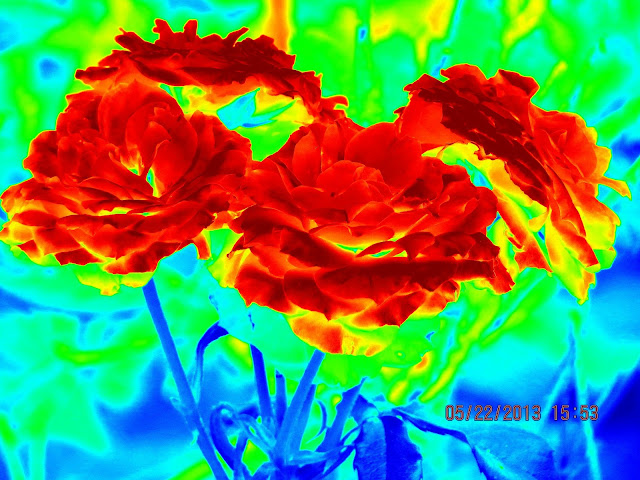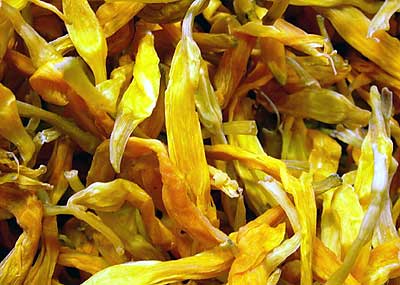Hi Everybody!!
How Hot have You ever got? The heat is coming. I thought we would start out with more "heat wave" images I created in Picasa. You put your photo in edit and push the button that says heat map. Presto, bingo a whole new outlook on life! Tonight, I heated up some images from my road trip to the Herb Farm. Linda is not going to believe this is her place! (HaHa). Anyway, I am making some cards with these bright shots. For your info from the Google Index, I have selected 2 garden delights that you can eat.
A really different treat!
I caught up with Linda and the landscaping crew, so the last of your photostudy is also shots from Bluebonnet. This is to remind YOU to go to your garden store and buy shade trees to plant to protect you from the coming Heat.
http://en.wikipedia.org/wiki/Daylily
Daylily
From Wikipedia, the free encyclopedia
Daylily is the general nonscientific name of a species, hybrid or cultivar of the genus Hemerocallis(pron.: /ˌhɛmɨroʊˈkælɪs/).[1] Daylily cultivar flowers are highly diverse in colour and form, as a result of hybridization efforts of gardening enthusiasts and professional horticulturalists. Thousands of registered cultivars are appreciated and studied by local and international Hemerocallis societies.[2] Hemerocallis is now placed in familyXanthorrhoeaceae, subfamily Hemerocallidoideae, and formerly was part of Liliaceae (which includes true lilies).
| Daylily | |
|---|---|
 | |
| Hemerocallis 'Hush Little Baby' | |
| Scientific classification | |
| Kingdom: | Plantae |
| Clade: | Angiosperms |
| Clade: | Monocots |
| Order: | Asparagales |
| Family: | Xanthorrhoeaceae |
| Subfamily: | Hemerocallidoideae |
| Genus: | Hemerocallis |
Culinary use [edit]
The flowers of some species[which?] are edible and are used in Chinese cuisine. They are sold (fresh or dried) in Asian markets as gum jum or golden needles (金针 in Chinese; pinyin: jīn zhēn) oryellow flower vegetables (黃花菜 in Chinese; pinyin: huáng huā cài). They are used in hot and sour soup, daylily soup (金針花湯), Buddha's delight, and moo shu pork. The young green leaves and the rhizomes of some (but not all[citation needed]) species are also edible. The plant has also been used for medicinal purposes. Care must be used as some species of lilies can be toxic.
Cicada:
http://en.wikipedia.org/wiki/Cicada
| Cicada | |
|---|---|
 | |
| Annual cicada, Tibicen linnei | |
| Calling song of Magicicada cassini | |
| Scientific classification | |
| Kingdom: | Animalia |
| Phylum: | Arthropoda |
| Class: | Insecta |
| Order: | Hemiptera |
| Suborder: | Auchenorrhyncha |
| Infraorder: | Cicadomorpha |
| Superfamily: | Cicadoidea |
| Family: | Cicadidae Westwood, 1840 |
Cicadas (/sɪˈkɑːdə/ or pron.: /sɪˈkeɪdə/) are insects in the order Hemiptera, suborder Auchenorrhyncha (which was formerly included in the now invalid suborder Homoptera). Cicadas are in the superfamily Cicadoidea. Their eyes are prominent, though not especially large, and set wide apart on the anterior lateral corners of the frons. The wings are well-developed, with conspicuous veins; in some species the wing membranes are wholly transparent, whereas in many others the proximal parts of the wings are clouded or opaque and some have no significantly clear areas on their wings at all. About 2,500 species of cicada have been described, and many remain to be described. Cicadas live in temperate-to-tropical climates where they are among the most-widely recognized of all insects, mainly due to their large size and unique sound. Cicadas are often colloquially called locusts,[1] although they are unrelated to true locusts, which are various species of swarming grasshopper. Cicadas are related to leafhoppersand spittlebugs.
Cicadas can cause damage to several cultivated crops, shrubs, and trees, mainly in the form of scarring left on tree branches while the females lay their eggs deep in branches.[3][4][5]
Many people around the world regularly eat cicadas. They are known to have been eaten in Ancient Greece as well as China, Malaysia, Burma, Latin America, and the Congo.[6] Female cicadas are prized for being meatier.[6]Shells of cicadas are employed in the traditional medicines of China.[7]

Deep-fried Cryptotympana atrata inShandong cuisine
http://en.wikipedia.org/wiki/File:Adult_Cicada_Emerging_from_Nymph_Skin.jpg
| Description |
English: Adult Cicada Emerging from Nymph Skin
Taken in Auburn, AL on September 9th, 2012. Photographer: Jim DeWitt
Camera: Nikon D40 |
| Date | |
| Source | I took these photos myself, on my property, with my camera. |
| Author | Roland311 |
....this is brendasue signing off from Rainbow Creek. See You next time! (New summer format-no vids on new posts). By now, You know how to find the vids! And, the Google Index! Celebrate your Smart Self!
Bluebonnet Herb Farm Hempstead, Texas USA
oooooooooooooooooooooooooooooo

































































No comments:
Post a Comment
Hi Everybody! Please say hello and follow so I know you are here! Due to the inconsideration of people trying to put commercials on my blog comment area, I have restricted use of anonymous posts. Sorry that some hurt all.
My public email is katescabin@gmail.com No spammers or trolls